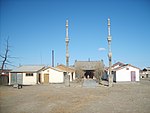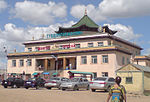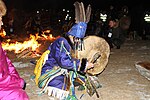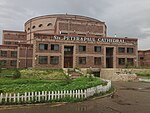Religion in Mongolia
Religion in Mongolia (census 2020)[1]

Religion in Mongolia has been traditionally dominated by the schools of Mongolian Buddhism and by Mongolian shamanism, the ethnic religion of the Mongols. Historically, through their Mongol Empire the Mongols were exposed to the influences of Christianity (Nestorianism and Catholicism) and Islam, although these religions never came to dominate. During the communist period of the Mongolian People's Republic (1924–1992) all religions were suppressed, but with the transition to the parliamentary republic in the 1990s there has been a general revival of faiths.
According to the national census of 2020, 51.7% of the Mongolians identify as Buddhists, 40.6% as non-religious, 3.2% as Muslims (predominantly of Kazakh ethnicity), 2.5% as followers of the Mongol shamanic tradition, 1.3% as Christians, and 0.7% as followers of other religions.[1]
Demographics
[edit]| Religion | 2010[1][2] | 2020[1] | ||
|---|---|---|---|---|
| Number | % | Number | % | |
| Buddhism | 1,459,983 | 53.0 | 1,704,480 | 51.7 |
| Islam | 82,641 | 3.0 | 105,500 | 3.2 |
| Mongolian shamanism | 79,886 | 2.9 | 82,422 | 2.5 |
| Christianity | 60,603 | 2.2 | 42,859 | 1.3 |
| Other religion | 11,019 | 0.4 | 23,078 | 0.7 |
| Non-religious | 1,063,308 | 38.6 | 1,338,528 | 40.6 |
| Total population | 2,754,685 | 100 | 3,296,866 | 100 |
Main religions
[edit]Buddhism
[edit]Buddhism in Mongolia began with the Yuan dynasty (1271–1368) emperors' conversion to Tibetan Buddhism. The Mongols returned to indigenous shamanic traditions after the collapse of the Mongol Empire, but Buddhism reemerged in the sixteenth and seventeenth centuries. During the communist Mongolian People's Republic (1924–1992), Buddhism was suppressed with an estimated 17,000 monks being killed under the regime, official figures show.[3] After the collapse of communism in the 1990s, there has been a resurgence of Buddhism in the country, both within the fold of the traditional monastic institution and through the spread of New Age-inspired and monotheism-inspired new religious movements of Buddhism.[4] According to the 2020 census of Mongolia, 51.7% of the population, that is 1,704,480 people, are adherents of Buddhism.[1]
-
Yurt pavilion of Dashchoilin Monastery in Ulaanbaatar, example of aboriginal Mongolian architecture.
-
Dulmalin Nunnery, a nunnery (female monastery) in Ulaanbaatar, and another example of Sino-Tibetan architecture.
-
Stupa of Dambadarjaalin Monastery in Ulaanbaatar.
-
Tuvdenpeljeelin Temple, a modern temple of Mongolian Buddhist astrology in Ulaanbaatar.
-
Shaduvlin Temple, a modern temple of the Foundation for the Preservation of the Mahayana Tradition.
Mongolian shamanism
[edit]Mongolian shamanism, more broadly called the Mongolian folk religion, or occasionally Tengrism, refers to the animistic and shamanic ethnic religion that has been practiced by the Mongols at least since the age of recorded history. The Mongolian name of the practice is Böö mörgöl (Бөө мөргөл). In the earliest known stages it was tied to all other aspects of social life and to the tribal organization of Mongolian society. When the Mongols adopted Buddhism, Mongolian shamanism was influenced and merged with the new religion. During the communist republic of the twentieth century it was heavily repressed, but after the fall of communism it was revived. According to the 2020 census, 2.5% of the population of Mongolia, that is 82,422 people, declare that they are shamans.[1]
Mongolian shamanism is centered on the worship of the tngri (gods) and the highest Tenger ("Heaven", "God of Heaven", or "God"), also called Qormusta Tengri. In the Mongolian folk religion, Genghis Khan is considered one of the embodiments, if not the main embodiment, of the supreme God. The Mausoleum of Genghis Khan in Ordos City, in Inner Mongolia, is an important center of this tradition.
Yellow shamanism is the term used to designate the particular version of Mongolian shamanism which adopts the expressive style of Buddhism. "Yellow" indicates Buddhism in Mongolian culture, since most Buddhists there belong to what is called the Gelug or "Yellow sect" of Tibetan Buddhism, whose members wear yellow hats while performing rituals. The term also serves to distinguish it from a form of shamanism not influenced by Buddhism, called black shamanism.
-
Yurt-shaped shamanic temple in Ulaanbaatar.
-
Interior of a shamanic temple in Ulaanbaatar.
-
Shamans preparing themselves to perform a rite at the Blue Pearl Festival at Lake Khövsgöl, in Khövsgöl Province.
-
Shaman performing a fire ritual at Lake Khövsgöl.
-
An ovoo on the sacred mount above Dambadarjaalin Monastery in Ulaanbaatar.
-
Shamanic temple on Chingeltei Uul, near Ulaanbaatar.
Abrahamic religions
[edit]Christianity
[edit]Christianity in Mongolia is the religion of 42,859 people according to the 2020 census, corresponding to 1.3% of the population.[1] Christians in Mongolia include Protestants, Catholics, Orthodox Christians, and Mormons of the Church of Jesus Christ of Latter-day Saints.
-
Protestant church in Zuunmod, Töv Province.
-
Saints Peter and Paul Cathedral in Ulaanbaatar, see of the Apostolic Prefecture of Ulaanbaatar of the Catholic Church.
-
Mormon meetinghouse in Sükhbaatar, Selenge Province.
Islam
[edit]Islam in Mongolia is the religion of 105,500 people as of the 2020 census, corresponding to 3.2% of the population.[1] It is mostly the religion of the Kazakh ethnic minority residing in the areas of Bayan-Ölgii Province and Khovd Province in western Mongolia. However, Kazakh communities may be found in cities and towns throughout all Mongolia.
-
Mosque in Bulgan, Bayan-Ölgii Province, a province inhabited predominantly by Kazakh Muslims
-
Mosque in Ölgii, Bayan-Ölgii
-
Mosque in Nalaikh, Ulaanbaatar
-
Mosque in Darkhan, Darkhan-Uul
Other religions
[edit]The 2020 census counted 23,078 people who were adherents of religions other than Buddhism, Mongolian shamanism, Islam or Christianity, corresponding to 0.7% of the total population of the country.[1]
The Bahá'í Faith was introduced in Mongolia only in the 1980s and 1990s, as prior to that point the communist ideology suppressed religions and impeded the spread of new ones. The first Bahá'í arrived in Mongolia in 1988, and founded a community of believers, later establishing a Bahá'í Local Spiritual Assembly. In 1994, the Bahá'ís elected their first National Spiritual Assembly.
Hinduism too has spread into Mongolia in the 1990s, after the collapse of the communist republic. The International Society for Krishna Consciousness (Hare Krishna) and Patanjali Yogpeeth have established themselves in Mongolia; at the same time some Mongolian Buddhists have incorporated Hindu concepts and techniques into their Buddhist religion.[4]
See also
[edit]References
[edit]- ^ a b c d e f g h i "2020 Population and Housing Census" (PDF). National Statistics Office of Mongolia. Archived from the original (PDF) on 7 November 2020.
- ^ "2010 Population and Housing Census". National Statistics Office of Mongolia.
- ^ Thomas, Natalie (2018-06-04). "Young monks lead revival of Buddhism in Mongolia after years of repression". Reuters. Retrieved 2023-07-06.
- ^ a b Abrahms-Kavunenko 2012, p. 292.
Bibliography
[edit]- Abrahms-Kavunenko, Saskia (1 January 2012). "Religious 'Revival' After Socialism? Eclecticism and Globalisation Amongst Lay Buddhists in Ulaanbaatar". Inner Asia. 14 (2): 279–297. doi:10.1163/22105018-90000005. JSTOR 24572065.
- Abrahms-Kavunenko, Saskia (2019). "Mongolian Buddhism in the Democratic Period". Oxford Research Encyclopedia of Religion. Oxford University Press. doi:10.1093/acrefore/9780199340378.013.618. ISBN 9780199340378.
- Atwood, Christopher P. (1996). "Buddhism and Popular Ritual in Mongolian Religion: A Reexamination of the Fire Cult" (PDF). History of Religions. 36 (2). University of Chicago Press: 112–139. doi:10.1086/463455. S2CID 162394887. Archived from the original (PDF) on 15 November 2020.
- Balogh, Matyas (2010). "Contemporary shamanisms in Mongolia". Asian Ethnicity. 11 (2): 229–238. doi:10.1080/14631361003779489. S2CID 145595446.
- Bumochir, D. (2014). "Institutionalization of Mongolian shamanism: from primitivism to civilization". Asian Ethnicity. 15 (4): 473–491. doi:10.1080/14631369.2014.939331. S2CID 145329835.
- Charleux, Isabelle (2008). "Chinggis Khan: Ancestor, Buddha or Shaman?". Mongolian Studies. 30/31 (4). Mongolia Society: 207–258. JSTOR 43193542. Archived from the original on 26 February 2020.
- Dashkovskiy, Petr (2015). "Ethnic and Religious Processes in Western Mongolia (Based on Social Research)". Procedia - Social and Behavioral Sciences. 185: 109–116. doi:10.1016/j.sbspro.2015.03.422.
- Heissig, Walther (1980) [1970]. The Religions of Mongolia. Translated by Geoffrey Samuel. London; Henley: Routledge; Kegan Paul. ISBN 978-0520038578.
- Hesse, Klaus (1986). "A Note on the Transformation of White, Black and Yellow Shamanism in the History of the Mongols". Studies in History. 2 (1): 17–30. doi:10.1177/025764308600200102. S2CID 162239153.
- Kollmar-Paulenz, Karénina (2017). "Of Yellow Teaching and Black Faith: Entangled Knowledge Cultures and the Creation of Religious Traditions" (PDF). In Bochinger, Christoph; Rüpke, Jörg (eds.). Dynamics of Religion. Past and Present. De Gruyter. pp. 231–250. doi:10.1515/9783110450934-013. ISBN 9783110450927. Archived from the original (PDF) on 18 February 2020.
- Man, John (2004). Genghis Khan: Life, Death and Resurrection. London, England: Bantam Press. ISBN 9780553814989.
- Schlehe, Judith (2004). "Shamanism in Mongolia and in New Age Movements". In Rasuly-Paleczek, Gabriele (ed.). Central Asia on Display: Proceedings of the VIIth Conference of the European Society for Central Asian Studies. Vol. 1. Vienna: Lit Verlag. pp. 283–296. ISBN 3825883094.
- Rinchen, Yönsiyebü (1981). "White, Black and Yellow Shamans Among the Mongols". Ultimate Reality and Meaning. 4 (2): 94–102. doi:10.3138/uram.4.2.94. Archived from the original on 11 November 2020.
- Shimamura, Ippei (2004). "Yellow Shamans (Mongolia)". In Walter, Mariko Namba; Neumann Fridman, Eva Jane (eds.). Shamanism: An Encyclopedia of World Beliefs, Practices, and Culture. Vol. 1. ABC-CLIO. pp. 649–651. ISBN 9781576076453.
- Turner, Kevin B. (2016). Sky Shamans of Mongolia: Meetings with Remarkable Healers. Berkeley, California: North Atlantic Books. ISBN 9781583946343.
- Wallace, Vesna A., ed. (2015). Buddhism in Mongolian History, Culture, and Society. New York: Oxford University Press. ISBN 978-0199958665.




















